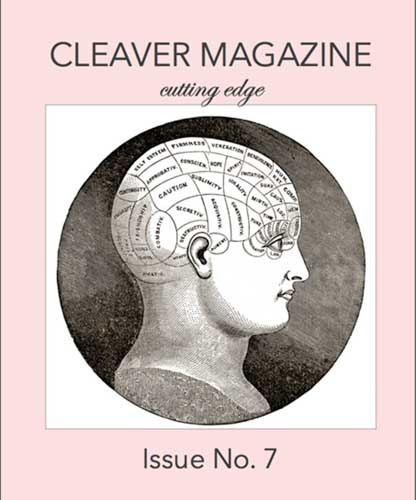Cleaver Magazine – September 2014
Not having reviewed Cleaver Magazine since its launch with the preview issue, I felt it was high-time I check back in to see how it is evolving, and this issue did not let me down. Each contribution to the issue is well thought-out and carefully crafted. After reading Amelia Fowler’s “Space and Time,” I was surprised to find out that it is her first publication. Props to Cleaver for snatching her up, because I imagine there is only more publications to come for this writer. Not having reviewed Cleaver Magazine since its launch with the preview issue, I felt it was high-time I check back in to see how it is evolving, and this issue did not let me down. Each contribution to the issue is well thought-out and carefully crafted.
After reading Amelia Fowler’s “Space and Time,” I was surprised to find out that it is her first publication. Props to Cleaver for snatching her up, because I imagine there is only more publications to come for this writer. The essay is broken into nine small sections about her experience with spatial sequence synesthesia, and while the content itself is interesting (I’ve never heard of it), the writing itself is also is clear and interesting to read. Her use of imagery helps to accentuate her subject matter: “Before I start kindergarten, my mother begins a job as a secretary. I spend most days at her office, drawing landscapes on long sheets of adding machine paper. Endless fields of little girls and cats.” The ninth and final section begins:
The past sits to my left, the future to my right, climbing at age twenty-five and plateauing again at thirty. Thirty years old until death looks like high flatland—what I conceive of as adulthood, perhaps, or a time I cannot fathom inhabiting. My life till thirty is symmetrical, I tell a therapist. Two slopes, a valley. After that, time is a tacked-on afterthought, a tail of years. I could draw you a picture, but I cannot explain why.
Tammy Delatorre’s “Living Arrangements” is written in the structure of a contract for a lease on a rented apartment/house, broken into sections such as “I. Landlord & Tenant” and “II. Terms and Conditions.” It’s a reflection on the spaces we occupy, who we occupy them with, and what’s we’re left with when the arrangement doesn’t work out. In “VII. Possessions and Abandonment,” she cleverly compares boyfriends to tenants and landlords: “In the moonlight, they’re like tenants wanting to occupy you; and in the morning light, they’re like landlords ready to evict you for the slightest transgression.” The entire piece is cleverly threaded and relatable, even to those who have had better luck with living arrangements than Delatorre seems to have had.
The rest of the issue contains four contributions of art (I was particularly amused by Alli Katz’s Cats collection), a graphic narrative by Emily Steinberg about her struggle to become pregnant through all means available, fiction, flash pieces, and, of course, poetry. One poem I read multiple times is Brian Clifton’s “Office Supplies,” which starts,
In the back, a Formica table waits
on off-white industrial tile. We clock-
out, pull paperclips from our throats:
purple ones, yellow ones, metallic, pink.
Our mouths never seem satisfied.
We cough them up enough in jagged
convulsions for our fingers to work
out like loose teeth. . . .
There’s lots to love here, and the editors make it easy by not only selecting great work but also by presenting it in a desirable manner with accompanying images with each piece, artists’ statements with the visual work, contributor bios, and easy navigation. I look forward to following Cleaver along with the many issues I’m sure are to come.
[www.cleavermagazine.com]






